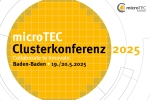Search Results
-
-
Press release - 06/03/2025 NMI TT in Reutlingen and Düsseldorf University Women's Hospital develop high-precision method for analyzing individual circulating tumor cells
Researchers have developed a new method that enables a more precise analysis of individual tumor cells circulating in the blood. This allows not only the previously possible genomic investigation of such tumor cells, but also the focused analysis of single-cell signaling pathways at the functional protein level. The combined analysis of the mutated genome and signaling proteins opens up new avenues for more targeted treatment methods.
https://www.gesundheitsindustrie-bw.de/en/article/press-release/nmi-tt-reutlingen-and-duesseldorf-university-womens-hospital-develop-high-precision-method-analyzing-individual-circulating-tumo -
Press release - 06/03/2025 New insights into the cellular mechanism of action of psilocybin
A recent study by the Hector Institute for Translational Brain Research at the CIMH provides the first cellular insights into how psilocin promotes the growth and networking of human nerve cells.
https://www.gesundheitsindustrie-bw.de/en/article/press-release/new-insights-cellular-mechanism-action-psilocybin -
Press release - 06/03/2025 Artificial Muscles for Tremor Suppression
Scientists at the Max Planck Institute for Intelligent Systems, the University of Tübingen and the University of Stuttgart under the Bionic Intelligence Tübingen Stuttgart (BITS) collaboration developed a biorobotic arm that can mirror human tremors. Artificial muscles on either side of the forearm contract and relax to suppress the involuntary shaking of the wrist and hand.
https://www.gesundheitsindustrie-bw.de/en/article/press-release/artificial-muscles-tremor-suppression -
Press release - 05/03/2025 Frank Winkler receives the Brain Prize 2025
This year, the Brain Prize worth more than one million euros, honors pioneering work on nervous system-cancer interactions: Neurologist Frank Winkler, who researches at the Heidelberg University and at the German Cancer Research Center and treats patients with brain tumors at the Heidelberg University Hospital, discovered that nerve cells in the brain communicate with brain tumor cells. This causes the disease to progress.
https://www.gesundheitsindustrie-bw.de/en/article/press-release/frank-winkler-receives-brain-prize-2025 -
Event - Life Science Investors’ Day 2025
Heidelberg, Networking eventhttps://www.gesundheitsindustrie-bw.de/en/event/life-science-investors-day-2025 -
Press release - 04/03/2025 Clusters of Metabolic Dysfunction-Associated Steatotic Liver Disease for Precision Medicine
People with metabolic dysfunction-associated steatotic liver disease (MASLD) and more so with metabolic dysfunction-associated steatohepatitis and MASLD-associated hepatic fibrosis can progress to cirrhosis and hepatocellular carcinoma and are at increased risk of developing type 2 diabetes, cardiovascular and chronic kidney disease, and cancers. Future research might be beneficial for implementing precision medicine in MASLD.
https://www.gesundheitsindustrie-bw.de/en/article/press-release/clusters-metabolic-dysfunction-associated-steatotic-liver-disease-precision-medicine -
Event - - BIO International Convention 2025
Boston, USA, Kongress/Symposiumhttps://www.gesundheitsindustrie-bw.de/en/event/bio-international-convention-2025 -
Event - - 
microTEC Clusterkonferenz 2025
Baden-Baden, Kongress/Symposiumhttps://www.gesundheitsindustrie-bw.de/en/event/microtec-clusterkonferenz-2025 -
Event - - BIONNALE 2025
Berlin / online, Registration deadline: Networking eventhttps://www.gesundheitsindustrie-bw.de/en/event/bionnale-2025 -
Event - - Swiss Biotech Day 2025
Basel, Kongress/Symposiumhttps://www.gesundheitsindustrie-bw.de/en/event/swiss-biotech-day-2025 -
Funding BoB – Best of Biotech
Competition, Funded by: Austria Wirtschaftsservice (aws), sb_search.searchresult.label.programSubmissionDate: 13/06/2025https://www.gesundheitsindustrie-bw.de/en/database/funding/bob-best-biotech -
Press release - 28/02/2025 Recognise developmental disorders early with AI: Automatically classifying movement patterns in babies
Using a new combination of three sensors and artificial intelligence, researchers at Heidelberg Medical Faculty of Heidelberg University and Heidelberg University Hospital are recognising patterns in babies' movements that show whether their nervous system is developing healthily.
https://www.gesundheitsindustrie-bw.de/en/article/press-release/recognise-developmental-disorders-early-ai-automatically-classifying-movement-patterns-babies -
Press release - 28/02/2025 Early Excellence in Science Award für Ivana Winkler
The Bayer Foundation's Early Excellence in Science Award 2024 in the category of Data Science goes to Ivana Winkler of the German Cancer Research Center (DKFZ). Winkler's work uncovered the unexpected effect of female reproductive capacity: the constantly recurring remodeling of the organs of the female reproductive tract during the sexual cycle leads to fibrosis and chronic inflammation over the years.
https://www.gesundheitsindustrie-bw.de/en/article/press-release/early-excellence-science-award-fuer-ivana-winkler -
Press release - 28/02/2025 Scientists discover the function of a mysterious HIV component
A research team including scientists from Heidelberg University Hospital has gained new insights into HIV-1. Researchers have discovered the mechanism behind an important step in the life cycle of HIV. Working together with teams at Heidelberg and Yale Universities, they found that the enigmatic “spacer peptide 2”, one of the virus components, plays a key role in converting immature HIV-1 particles into infectious particles.
https://www.gesundheitsindustrie-bw.de/en/article/press-release/scientists-discover-function-mysterious-hiv-component -
Press release - 27/02/2025 EU Project: New Molecular Interventions against Virus Infections
Targeted molecular interventions in the replication cycle and the immune recognition of viruses are intended to prevent viral entry into cells and virus replication. Scientists work on new approaches to combating highly dangerous viral diseases such as yellow fever or Lassa fever. The European Union is supporting the project over a period of five years to the tune of just under eight million euros.
https://www.gesundheitsindustrie-bw.de/en/article/press-release/eu-project-new-molecular-interventions-against-virus-infections -
Press release - 25/02/2025 Self-healing hearts How Zebrafish regenerate heart muscle cells
Zebrafish can completely replace damaged heart muscle cells: The affected organ becomes fully functional again. Researchers at Ulm University have discovered that a specific cell-to-cell communication signal helps them to cope better with replication stress. This stress inhibits tissue regeneration in humans and mammals as they age. In Zebrafish a signalling protein ensures that the cells of the damaged organ continue to divide and thus multiply.
https://www.gesundheitsindustrie-bw.de/en/article/press-release/self-healing-hearts-how-zebrafish-regenerate-heart-muscle-cells -
Press release - 25/02/2025 Protein with contradictory properties: secret revealed
A protein with contradictory properties: Despite its large negative surface charge, it has a strong tendency to take up electrons, which are also negatively charged. The researchers discovered positively charged calcium ions inside the protein very near the electrons, counteracting their charge. They see this as a natural way of handling opposing electrical charges and allowing the protein to optimally fulfill its biological function.
https://www.gesundheitsindustrie-bw.de/en/article/press-release/protein-contradictory-properties-secret-revealed -
Controllable microcatheters - 20/02/2025 
Robot-assisted control of surgical instruments using magnetic resonance imaging
Catheter-based examinations and surgical procedures are severely limited by the restricted controllability of conventional instruments and harmful radiation exposure to both patients and medical staff caused by prolonged exposure to radiation during fluoroscopy. EndoSurge, a Stuttgart-based start-up, has developed innovative robotic microcatheters that can be precisely controlled using the magnetic field of an MRI device.
https://www.gesundheitsindustrie-bw.de/en/article/news/robot-assisted-control-surgical-instruments-using-magnetic-resonance-imaging -
Press release - 17/02/2025 Pancreatic cancer: blocked nerves as a possible new treatment strategy
Pancreatic cancer is fueled by connections to the nervous system. This is reported by scientists from the German Cancer Research Center (DKFZ) and the Heidelberg Institute for Stem Cell Technology and Experimental Medicine (HI-STEM)*. The team discovered that the tumor reprograms the neurons for its own benefit.
https://www.gesundheitsindustrie-bw.de/en/article/press-release/pancreatic-cancer-blocked-nerves-possible-new-treatment-strategy -
Press release - 13/02/2025 Guardian molecule keeps cells on track – new perspectives for the treatment of liver cancer
A guardian molecule ensures that liver cells do not lose their identity. The discovery is of great importance for cancer medicine because a change of identity of cells has come into focus as a fundamental principle of carcinogenesis for several years. The research team was able to show that the newly discovered guardian is so powerful that it can slow down highly potent cancer drivers and cause malignant liver tumors to regress in mice.
https://www.gesundheitsindustrie-bw.de/en/article/press-release/guardian-molecule-keeps-cells-track-new-perspectives-treatment-liver-cancer -
Press release - 12/02/2025 Therapeutic Designer Peptide to Combat Acute Heart Muscle Weakness
Researchers of the Heidelberg University, Heidelberg University Hospital (UKHD) and Heidelberg Institute for Theoretical Studies (HITS) have developed a synthetic peptide based on the natural protein S100A1, a nearly universal “fuel” for weakened hearts. The researchers combined computer-aided methods with lab studies to investigate the therapeutic effect of the so called S100A1ct peptide molecule.
https://www.gesundheitsindustrie-bw.de/en/article/press-release/therapeutic-designer-peptide-combat-acute-heart-muscle-weakness -
Press release - 11/02/2025 New perspectives for personalized therapy of brain tumors
Scientists from the German Cancer Research Center (DKFZ) and ShanghaiTech University have developed an innovative method for growing brain tumors of individual patients in the laboratory that mimic the original structure and the molecular property of the parental tumor as closely as possible. Drug tests in this model were found to correlate very well with actual patient responses, making it a valuable method for investigating therapies.
https://www.gesundheitsindustrie-bw.de/en/article/press-release/new-perspectives-personalized-therapy-brain-tumors -
Press release - 10/02/2025 Medical textiles with infection protection
In collaboration with Heraeus, the German Institutes of Textile and Fiber Research (DITF) are developing fibers and textiles with a novel infection protection system. The basis is an antimicrobial mechanism of action licensed from Heraeus and marketed under the name AGXX. The goal of the collaboration is to optimally integrate the AGXX technology into textile finishes and coatings and to incorporate it into fiber-spinnable polymers.
https://www.gesundheitsindustrie-bw.de/en/article/press-release/medical-textiles-infection-protection -
Press release - 07/02/2025 Spliceosome: How cells avoid errors when manufacturing mRNA
The spliceosome, ensures that the genetic information from the genome, after being transcribed into mRNA precursors, is correctly assembled into mature mRNA. Splicing is a basic requirement for producing proteins. Researchers at the Heidelberg University Biochemistry Center (BZH) have succeeded for the first time in depicting a faultily “blocked” spliceosome at high resolution and reconstructing how it is recognized and eliminated in the cell.
https://www.gesundheitsindustrie-bw.de/en/article/press-release/spliceosome-how-cells-avoid-errors-when-manufacturing-mrna